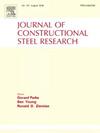Fatigue assessment of welded joints considering local geometry based on the zero-point effective notch stress method
IF 4
2区 工程技术
Q1 CONSTRUCTION & BUILDING TECHNOLOGY
引用次数: 0
Abstract
Local geometric discontinuity in welded components can have a significant impact on the high-cycle fatigue performance. However, the widely used fatigue assessment method for welded joint cannot adequately account for this effect. In the work, the zero-point effective notch stress (ZPENS) method is introduced as an alternative for fatigue assessment of welded joints and compared with nominal stress method, structural hot-spot stress method, effective notch stress method, and strain energy density method. A total of 295 fatigue data points, including cruciform, butt and T-joints, were collected from the literature for comparison. The results demonstrate that the ZPENS method can effectively capture the effect of local geometry on fatigue property and reduce the scatter in fatigue data compared to other methods. Additionally, the thickness correction formula recommended by the IIW is also applicable to the ZPENS method, further reducing fatigue data scatter induced by the size effect.
求助全文
约1分钟内获得全文
求助全文
来源期刊

Journal of Constructional Steel Research
工程技术-工程:土木
CiteScore
7.90
自引率
19.50%
发文量
550
审稿时长
46 days
期刊介绍:
The Journal of Constructional Steel Research provides an international forum for the presentation and discussion of the latest developments in structural steel research and their applications. It is aimed not only at researchers but also at those likely to be most affected by research results, i.e. designers and fabricators. Original papers of a high standard dealing with all aspects of steel research including theoretical and experimental research on elements, assemblages, connection and material properties are considered for publication.
 求助内容:
求助内容: 应助结果提醒方式:
应助结果提醒方式:


